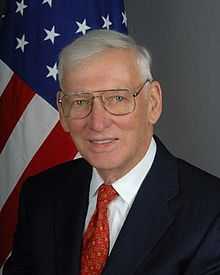Ireland–United States relations
 | |
Ireland |
United States |
|---|---|
Ireland–United States relations refers to the current and historical bilateral relationship between Ireland and the United States.
According to the 2012 U.S. Global Leadership Report, 67% of Irish people approve of U.S. leadership, the fourth-highest rating for any surveyed country in Europe.[1]
History
According to the government of the United States, U.S. relations with Ireland have long been based on common ancestral ties and shared values.[2] Besides regular dialogue on political and economic issues, the U.S. and Irish governments have official exchanges in areas such as medical research and education. In May 2011, U.S. President Barack Obama visited Ireland.[3]
With Ireland's membership in the European Union, the discussion of EU trade and economic policies, as well as other aspects of EU policy, is also a key element in the U.S.-Irish relationship. In recent years, Ireland has attempted to act as a diplomatic bridge between the United States and the European Union. During its 2004 EU presidency, Ireland worked to strengthen U.S.-EU ties that had been strained by the Iraq War, and the current EU Ambassador to the United States is former Irish Prime Minister John Bruton. Ireland operates a policy of military neutrality, in contrast with the United States' military activities. Ireland has also assisted US troops en route to Afghanistan by permitting US aircraft to stop over at Shannon International Airport to refuel.
Emigration, long a vital element in the U.S.–Irish relationship, declined significantly with Ireland's economic boom in the 1990s. For the first time in its modern history, Ireland experienced high levels of inward migration, a phenomenon with political, economic, and social consequences. However, Irish citizens do continue the common practice of taking temporary residence overseas for work or study, mainly in the US, UK, and elsewhere in Europe, before returning to establish careers in Ireland. The US J-1 visa program, for example, remains a popular means for Irish youths to work temporarily in the United States.[4]
Economic ties

Subsidiaries of US multinationals have located in Ireland due to low taxation. Ireland is the world's most profitable country for US corporations, according to analysis by US tax journal Tax Notes[5]
In 2010, trade between Ireland and the United States was worth around $36.25 billion. U.S. exports to Ireland were valued at $7.85 billion while Irish exports to the U.S. were worth some $28.4 billion, with Ireland having a trade surplus of $20.5 billion over the U.S.[6] The range of U.S. products imported to Ireland includes electrical components, computers and peripherals, pharmaceuticals, electrical equipment, and livestock feed. Exports to the United States include alcoholic beverages, chemicals and related products, electronic data processing equipment, electrical machinery, textiles and clothing, and glassware.
U.S. foreign direct investment in Ireland has been particularly important to the growth and modernization of Irish industry since 1980, providing new technology, export capabilities, and employment opportunities. The major U.S. investments in Ireland to date have included multi-billion dollar investments by Intel, Dell, Microsoft, IBM, Wyeth, Quintiles, Google, EMC and Abbott Laboratories. Currently, there are more than 600 U.S. subsidiaries operating in Ireland, employing in excess of 100,000 people and spanning activities from manufacturing of high-tech electronics, computer products, medical supplies, and pharmaceuticals to retailing, banking and finance, and other services. Many U.S. businesses find Ireland an attractive location to manufacture for the EU market, since as a member of the EU it has tariff free access to the European Common Market. Government policies are generally formulated to facilitate trade and inward direct investment. The availability of an educated, well-trained, English-speaking work force and relatively moderate wage costs have been important factors. Ireland offers good long-term growth prospects for U.S. companies under an innovative financial incentive programme, including capital grants and favourable tax treatment, such as a low corporation income tax rate for manufacturing firms and certain financial services firms. Irish firms are now beginning to provide a lot of employment in the U.S., for example indigenous Irish companies, particularly in the high tech sector have provided in excess of 80,000 jobs to date for American citizens.[citation needed]
Embassy

The U.S. embassy is in Dublin.
Principal U.S. Officials include:
- Ambassador – Daniel M. Rooney
- Deputy Chief of Mission – Robert Faucher
- Management Section Chief – Douglas Brown
- Senior Commercial Officer – Mitch Auerbach
- Consular Section Chief – Daniel Toma
- Defense Attaché – Col. Paul Flynn
- Political/Economic Section Chief – Ted Pierce
- Regional Security Officer – Terry Cobble
- U.S. Customs and Border Protection Port Director – Juan Soltero
- Public Affairs Officer – Sheila Paskman
See also
- Irish Americans
- Foreign relations of the United States
- Foreign relations of the Republic of Ireland
- Irish diaspora
References
- ↑ U.S. Global Leadership Project Report - 2012 Gallup
- ↑ Ireland US Department of State Retrieved 2011-02-20
- ↑ Obama in Ireland: president searches for 'missing apostrophe' The Telegraph, 23 May 2011
- ↑ http://www.state.gov/r/pa/ei/bgn/3180.htm
- ↑ "Ireland top location for US Multinational Profits". Finfacts.ie. Retrieved 2009-07-09.
- ↑ "Country Trade Profile". Massachusetts Institute of Technology. Retrieved 26 October 2013.
![]() This article incorporates public domain material from websites or documents of the United States Department of State (Background Notes).
This article incorporates public domain material from websites or documents of the United States Department of State (Background Notes).
External links
![]() Media related to Ireland – United States relations at Wikimedia Commons
Media related to Ireland – United States relations at Wikimedia Commons
| ||||||||||||||||||||||||||

.svg.png)